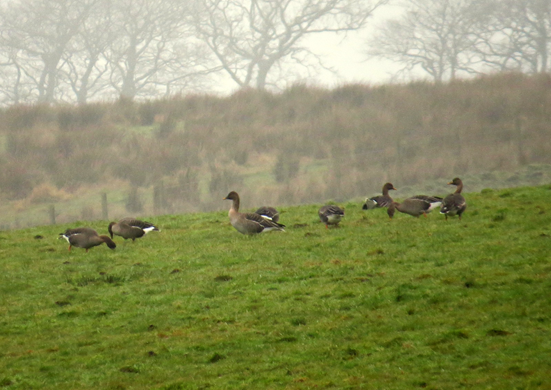 LINKED PAPER
LINKED PAPER
Multi-scale habitat selection and spatial analysis reveals a mismatch between the wintering distribution of a threatened population of Taiga Bean Geese Anser fabalis and its protected area. Thornton, M.J., Mitchell, C., Griffin, L.R., Briers, R.A., Minshull, B., Maciver, A. & White, P.J.C. 2021 Bird Study. doi: 10.1080/00063657.2021.1966740 VIEW
Protected areas are widely recognized as essential components of biodiversity conservation strategies around the world (European Environment Agency 2012). However, there is rarely any post-designation review to determine whether these areas continue to meet the conservation requirements of their focal habitats and species (Geldmann et al. 2013, Stroud et al. 2016). For bird species, this requires a good understanding of habitat use at different spatial and temporal scales, to identify their roosting, foraging, and breeding habitats (Wiens 1989, Fuller 2012). For some focal species, protected areas will be unable to meet all their conservation requirements at a large enough spatial scale, and other conservation measures may be required (Guixé et al. 2011).
The Taiga Bean Goose (Anser fabalis) is one of Scotland’s rarest migratory birds, with only one small population, amounting to fewer than 300 birds, wintering on the Slamannan Plateau, near Falkirk in central Scotland (centred at 55.94oN 3.88oW). It remains one of the few declining goose species in Europe, with an estimated population of 100,000 in the mid-1990s, declining to 63,000 in 2009. It is on the IUCN Red List of Threatened Species, breeding in Scandinavia and western Russia, and wintering mainly in southern Sweden, Denmark and, to a lesser extent, in northern Germany and Poland. Small numbers also winter in The Netherlands and Britain. The loss, fragmentation and degradation of suitable habitat to forestry and infrastructural development is one of the principal threats affecting this species. An international Action Plan provides details for the conservation of Taiga Bean Geese across its global range (Majakangs et al. 2015).
NatureScot (formerly Scottish Natural Heritage) designated a Site of Special Scientific Interest (SSSI) (hereafter protected area) in 2006 to safeguard the roost sites and foraging areas of the Slamannan Plateau Bean Goose population. The boundary of the protected area was selected to include fields which included 99% of all Bean Geese counted between the winters of 2000/01 and 2004/05. A management scheme was introduced in 2006 to support beneficial land management for the species within the protected area.
The objectives of this study were to (i) undertake a habitat selection analysis at the population foraging range scale, using field count data, to understand how the selection of agriculturally improved pasture foraging habitat varies in relation to habitat, spatial, and disturbance variables, (ii) use global positioning system (GPS) telemetry data to quantify habitat selection at the individual foraging range scale, and (iii) quantify the extent to which the contemporary foraging range of Bean Geese overlaps with the protected area.
A five-year (2011/12 – 2015/16) field count dataset was used to quantify foraging habitat selection at the population range scale. In addition, global positioning system (GPS)/ultra-high frequency loggers were attached to 12 birds and GPS location data were collected to quantify foraging habitat selection at an individual foraging range scale.
Generalized linear models predicted that, at the population foraging range scale, Taiga Bean Geese selected agriculturally improved pasture, and this selection was more pronounced at greater distances from public roads. At an individual foraging range scale, compositional analysis revealed that agriculturally improved pasture was significantly selected over all other habitats.
When the protected area was designated for the geese in 2006, most of the population roosted and foraged within its boundaries. However, this research has shown that their foraging distribution has shifted to areas largely outside the protected area (Fig. 1). The management scheme was no longer directly supporting habitats now being used by the geese, and therefore the scheme was closed in 2018.

Figure 1 Geographical comparison of the protected area footprint (which was based on field count data from 2000/2001–2004/2005) with field use between 2011/2012 and 2015/2016 using the same 99-percentile selection criterion that was used to select the original protected area boundary.
This work has highlighted the importance of on-going monitoring of priority bird species to ensure that conservation measures match their distribution and habitat requirements. For bird species using highly modified habitats, such as agricultural land, flexible species conservation measures should ideally track shifts in their distribution.
References
European Environment Agency (EEA). 2012. Protected areas in Europe – an overview . EEA Report No 5/2012, EEA Report No. 5/2012. VIEW
Fuller, R.J. 2012. Birds and Habitat: relationships in changing landscapes, ecological reviews. Cambridge University Press, New York. VIEW
Geldmann, J., Barnes, M., Coad, L., Craigie, I.D., Hockings, M. & Burgess, N.D. 2013. Effectiveness of terrestrial protected areas in reducing habitat loss and population declines. Biological Conservation 161: 230-238. VIEW
Guixé, D. & Arroyo, B. 2011. Appropriateness of special protection areas for wide-ranging species: the importance of scale and protecting foraging, not just nesting habitats. Animal Conservation 14: 391-399. VIEW
Marjakangas, A., Alhainen, M., Fox, A.D., Heinicke, T., Madsen, J., Nilsson, L. & Rozenfeld, S. 2015. International single species action plan for the conservation of the Taiga Bean Goose Anser fabalis fabalis. Bonn, Germany.
Stroud, D.A., Bainbridge, I.P., Maddock, A., Anthony, S., Baker, H., Buxton, N., Chambers, D., Enlander, I., Hearn, R.D., Jennings, K.R, Mavor, R., Whitehead, S. & Wilson, J.D. – on behalf of the UK SPA & Ramsar Scientific Working Group. 2016. The Status of UK SPAs in the 2000s: The Third Network Review. JNCC, Peterborough. VIEW
Wiens, J.A. 1989. The Ecology of Bird of Communities (Two Volumes). Cambridge University Press, Cambridge. VIEW
Image credit
Top right: Taiga Bean Geese Anser fabalis © Michael Thornton.
If you want to write about your research in #theBOUblog, then please see here.




